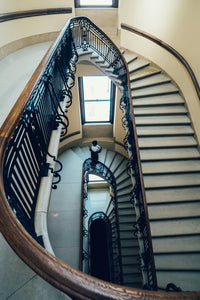It’s common for people to not differentiate between banisters and railings, often without realizing they refer to different things. While they’re closely related and serve similar purposes, banisters and railings have distinct differences that are worth understanding—whether for safety, design, or practicality. Let’s clear up the confusion and break down what sets them apart.
Definitions of Banisters and Railings
Banisters
A banister is a system designed to provide support and safety on staircases. It usually includes a handrail, balusters, newel posts, and occasionally a bottom rail. This setup is commonly found on open staircases, serving both functional and decorative purposes.
Railings
A railing is a simpler structure designed for support and safety. It typically consists of a handrail, which is often mounted directly to a wall or supported by posts. Railings are commonly used along enclosed staircases or edges where a full banister system is unnecessary.
Components Breakdown
Banister Components
-
Handrail: The handrail is the horizontal or angled component of a staircase system designed to be grasped for stability and support while ascending or descending stairs. It is typically positioned at a comfortable height to ensure ease of use and safety.
-
Balusters: Balusters are the vertical posts or spindles that run between the handrail and the bottom rail (or directly to the staircase). Their primary function is to prevent falls by creating a barrier, and they can also contribute to the aesthetic design of the staircase with various styles and materials.
-
Newel Posts: Newel posts are the larger, more robust vertical supports placed at the ends, corners, or turning points of a staircase. They serve as the anchor points for the handrail and add structural stability to the overall system.
-
Bottom Rail: The bottom rail is the horizontal component located at the base of the balusters. It connects the balusters and provides additional stability to the system, ensuring alignment and reinforcing the structure.
Railing Components
-
Handrail: The handrail is the main horizontal or angled component of a railing system, designed to be held for support and stability while navigating stairs or elevated areas. It is typically mounted at an ergonomic height for comfort and safety.
-
Brackets/Mounts: Brackets or mounts are the fixtures used to attach the handrail to a wall, posts, or other structures. They provide the necessary support to keep the handrail securely in place and are available in various designs to match the style of the railing.
-
Posts (if applicable): Posts are vertical supports that hold up the handrail in areas where it is not mounted directly to a wall. They provide structural integrity and ensure the railing remains stable.
Functional Differences between Railings and Banisters
Banisters
A banister is designed to offer reliable support and safety, particularly on the open sides of staircases where there’s no wall to provide a barrier. It helps prevent falls and makes using the stairs more secure. At the same time, it adds to the overall look of the staircase, with a variety of design options available to suit different styles and preferences.
Railings
A railing provides support and stability along enclosed staircases or corridors, where there’s already a wall for added safety. It’s a simple and practical solution that doesn’t take up much space and is often more cost-effective than a full banister system.
Design and Aesthetic Differences Between Railings and Banisters
Banisters
A well-designed banister can enhance the overall look of your space, whether you’re aiming for a classic, modern, or rustic style. Incorporating a banister into your home design involves choosing a style and finish that complements your existing décor. Whether it blends seamlessly with the surroundings or acts as a statement piece, a thoughtfully chosen banister can tie the entire space together.
When it comes to banister designs, some styles are more common due to their timeless appeal and versatility. Popular options include classic designs with traditional carved details, minimalist modern styles with clean lines, rustic designs with natural finishes, intricate wrought iron patterns, and contemporary glass-panel banisters.
Railings
Their simplicity makes them easy to incorporate into different interior or exterior styles, from modern and minimalist to more traditional designs. Choosing a railing involves selecting a design and finish that matches your space’s aesthetic, whether it’s understated and functional or a sleek, modern feature that enhances the architecture.
Some railing designs are particularly popular because of their versatility and widespread appeal. Common choices include wall-mounted railings for enclosed spaces, minimalist cable railings for a clean look, classic metal railings with subtle detailing, glass railings for a modern and open feel, and horizontal bar railings for a contemporary touch.
Material Options
When it comes to materials railings and banisters are usually made of, the most common options include:
-
Hardwood (oak, maple, cherry) and softwood (e.g., pine, cedar)
-
Metals such as wrought iron, steel (stainless or mild steel), aluminum, brass.
-
Tempered glass (clear, frosted, or tinted)
-
Stainless steel cables (typically for railings)
-
PVC or vinyl - which is often used for railings in outdoor settings
-
Marble or granite handrails which are most popular in luxury settings
-
As well as combinations of wood and metal, glass and metal, or other mixed material designs for unique aesthetics.
Considerations
When choosing materials for banisters or railings, it’s important to consider durability, maintenance, and how well they complement the overall design of your space. Durability is key, as these structures need to withstand daily use and, in some cases, exposure to the elements if installed outdoors. Maintenance is another factor; some materials, like wrought iron, may require occasional painting or sealing, while others, like stainless steel or glass, are easier to clean and maintain. Finally, the material should align with the aesthetic of your home.
Banister Design and Style Pairing Guide
| Home Style | Banister Design | Material | Finish | Styling Tip |
| Traditional | Classic with carved details | Hardwood (oak or maple) | Polished or stained wood | Pair with ornate lighting and traditional rugs. |
| Modern | Minimalist with clean lines | Metal or steel | Matte black or brushed steel | Complement with neutral tones and minimal decor. |
| Rustic | Rough-hewn wood design | Reclaimed natural wood | Natural wood grain or distressed | Add earthy tones and natural textures in the space. |
| Industrial | Metal with geometric patterns | Wrought iron or steel | Raw or matte black metal | Combine with exposed brick and natural lighting. |
| Contemporary | Glass panel with sleek handrail | Tempered glass with metal accents | Glossy or frosted metal | Match with modern furniture and open layouts. |
Railing Design and Style Pairing Guide
| Homestyle | Railing design | Material | Finish | Styling Tip |
| Traditional | Simple metal with vertical balusters | Wrought iron or steel | Painted or powder-coated metal | Pair with traditional furnishings and neutral tones |
| Modern | Cable railing with sleek lines | Stainless steel and cables | Brushed or polished | Combine with open spaces and minimal decor |
| Rustic | Wooden railing with natural finish | Natural wood or reclaimed wood | Stained or raw wood | Incorporate earthy textures and cozy elements |
| Industrial | Pipe railing with raw metal look | Steel or aluminum pipes | Raw or matte black metal | Match with exposed pipes and industrial lighting |
| Contemporary | Glass railing with minimalist frame | Tempered glass with metal accents | Glossy or frosted glass with matte metal | Complement with modern furniture and clean lines |
Banister or Railing - Which One to Choose?
We’ve already discussed how staircase design, whether open or enclosed, and aesthetic preferences play a key role in choosing the right banister or railing. However, there are additional considerations to keep in mind:
-
Maintenance requirements
-
Safety regulations
-
Budget
Conclusion
Understanding the differences between banisters and railings is essential for making informed decisions about staircase design and functionality. The distinctions between these terms can be subtle, but they have a significant impact when it comes to planning or discussing a project. Additionally, regional variations in terminology can further complicate matters; in some areas, "banister" might be used to describe any staircase structure, while in others, "railing" is the more common term. This highlights the importance of clear communication with contractors, designers, and suppliers to ensure that everyone involved in the project has the same understanding.
If you would like to learn more about our extensive offer of wrought iron handrails, feel free to contact us.









